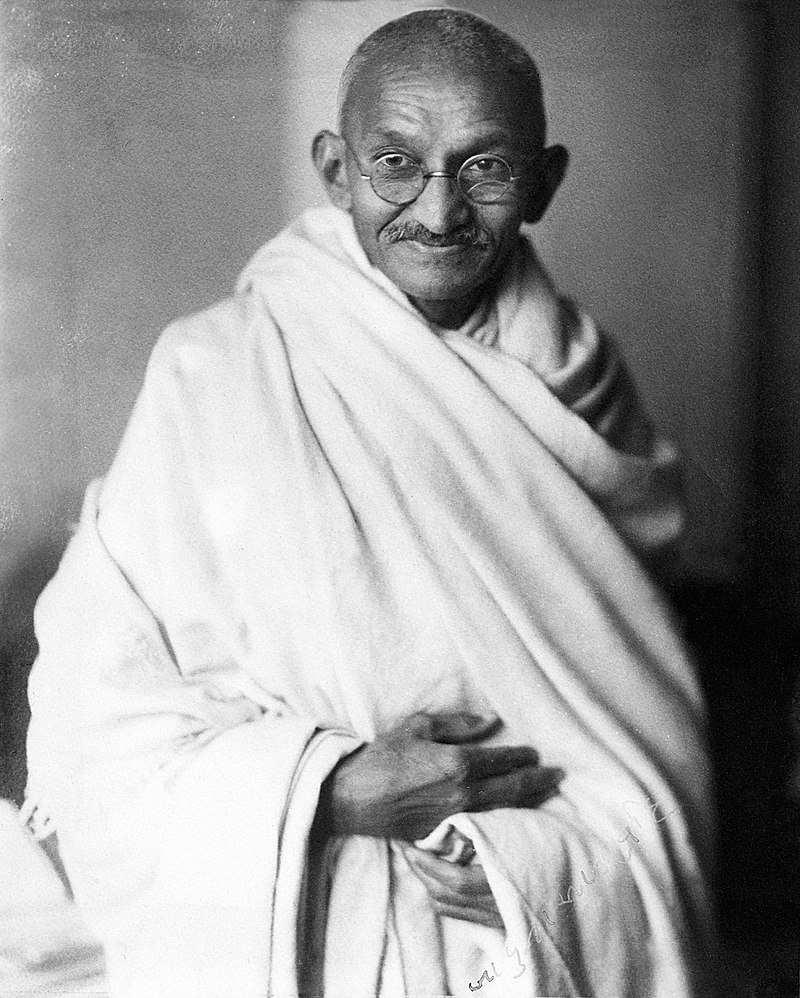Mahatma Gandhi (1869-1948) was a key leader in India’s struggle for independence against British rule. He is renowned for his philosophy of nonviolent resistance, advocating civil disobedience as a powerful force for social and political change. Gandhi’s efforts played a pivotal role in India gaining independence in 1947. He is often referred to as the “Father of the Nation” in India.
Early Life and Education
Mahatma Gandhi’s early life and education laid the foundation for his transformative journey as a leader of India’s struggle for independence. Born on October 2, 1869, in Porbandar, a coastal town in the state of Gujarat, India, Gandhi was named Mohandas Karamchand Gandhi. His birth into a modest family of the Vaishya, or business caste, was characterized by a strong influence of religious and moral values.
Gandhi’s father, Karamchand Gandhi, served as the diwan, or chief minister, of Porbandar. Despite his official position, Karamchand was known for his simplicity and integrity. These traits left a lasting impression on the young Gandhi, instilling in him a sense of duty and a commitment to truthfulness from an early age. Gandhi’s mother, Putlibai, was deeply religious and played a significant role in shaping his spiritual development.
Growing up in a devout Hindu household, Gandhi was exposed to the teachings of the Bhagavad Gita, the Ramayana, and other religious texts. The concept of ahimsa, or nonviolence, was ingrained in his upbringing, setting the stage for the principles that would later define his philosophy of resistance. His early exposure to the Jain principle of ‘live and let live’ also contributed to the formation of his nonviolent worldview.
In 1876, at the age of six, Gandhi entered primary school. A reserved and somewhat timid child, he struggled with the early years of formal education. His difficulties in expressing himself verbally and his fear of public speaking marked the beginning of a personal journey to overcome these challenges, ultimately leading him to become one of the most influential communicators in history.
At the age of thirteen, Gandhi was married to Kasturba Makhanji, also known as Ba. This early marriage was a common practice in his community, and Gandhi and Kasturba would go on to have four children together. This aspect of Gandhi’s life reflected the traditions and societal norms prevalent in 19th-century India.
In 1888, at the age of 18, Gandhi left India to pursue legal studies in London. This marked a significant departure from his cultural and familial environment, exposing him to Western thought and lifestyle. Studying law was not merely a career choice for Gandhi; it was a means to gain a deeper understanding of justice and to empower himself to address the injustices he would later encounter.
His time in London was transformative, not only academically but also culturally and spiritually. Gandhi embraced vegetarianism and delved into various religious and philosophical texts, including the Bible and works by Tolstoy and Thoreau. It was during this period that he developed a keen interest in social and political issues, setting the stage for his future activism.
After completing his legal studies, Gandhi faced a dilemma. He was offered a position to practice law in London, but he chose a different path. In 1893, Gandhi accepted an offer to work in South Africa, setting the stage for a pivotal chapter in his life. Little did he know that his experiences in South Africa would shape his philosophy of resistance and pave the way for his leadership in India’s struggle for independence.
Gandhi’s experiences in South Africa were marked by the harsh realities of racial discrimination. His confrontation with the deeply entrenched prejudices against Indians, particularly in the province of Natal, became a catalyst for his activism. The incident on a train journey from Durban to Pretoria, where he was ejected from a first-class compartment due to his skin color, became a turning point. This injustice fueled Gandhi’s resolve to fight against racial discrimination through nonviolent means.
In 1894, Gandhi founded the Natal Indian Congress in South Africa, aimed at addressing the rights and grievances of the Indian community. Over the next two decades, he led numerous campaigns against discriminatory laws such as the Asiatic Registration Act, which required all Indians to register and carry passes. These early struggles in South Africa laid the groundwork for the development of his philosophy of Satyagraha, or truth-force.
The concept of Satyagraha emphasized the power of truth and nonviolence in confronting injustice. It was not merely a political strategy but a way of life for Gandhi. This philosophy, influenced by his deep spiritual convictions, formed the core of his approach to social and political change.
Gandhi’s early activism in South Africa brought him into contact with a diverse array of people, both Indian and non-Indian, who would become instrumental in shaping his understanding of humanity and justice. The struggles in South Africa also honed his skills as a leader and strategist, setting the stage for his return to India in 1915 as a seasoned activist and leader.
South Africa Years
Mahatma Gandhi’s years in South Africa were transformative, laying the groundwork for his philosophy of nonviolent resistance and shaping his identity as a leader. Arriving in South Africa in 1893 to work as a lawyer, Gandhi’s initial experiences were marked by the harsh realities of racial discrimination, sparking a personal and political awakening.
Gandhi’s first significant confrontation with discrimination occurred during a train journey from Durban to Pretoria in 1893. Despite holding a first-class ticket, he was ejected from the compartment due to his Indian heritage. This incident became a catalyst for his activism, prompting him to challenge the unjust treatment of Indians in South Africa.
In response to the discriminatory laws targeting the Indian community, Gandhi founded the Natal Indian Congress in 1894. This organization became a platform for advocating the rights of Indians and opposing oppressive legislation. One of the early campaigns led by Gandhi was against the Asiatic Registration Act of 1906, which required all Indians, including women and children, to register and carry passes at all times. This marked the beginning of Gandhi’s engagement in civil disobedience and nonviolent resistance.
Gandhi’s approach to activism in South Africa was rooted in his evolving philosophy of Satyagraha. The term, meaning “truth-force” or “soul-force,” encapsulated his belief in the transformative power of nonviolence and the pursuit of truth. Satyagraha became more than a political tool; it was a way of life for Gandhi, emphasizing moral courage, self-discipline, and a commitment to justice.
The year 1906 proved to be a pivotal moment in Gandhi’s South African journey. In protest against the oppressive Asiatic Registration Act, he organized a gathering of Indians in Johannesburg. During this meeting, he introduced the practice of taking a collective vow to resist unjust laws through nonviolent means. This marked the formal inception of Satyagraha as a method of protest.
Gandhi’s commitment to nonviolence was further tested during the Bambatha Rebellion in 1906. The British colonial authorities called on Indians to assist in suppressing the Zulu uprising, a request that Gandhi initially supported. However, as the violence escalated, he realized the contradiction between advocating nonviolence and participating in armed conflict. This realization deepened his commitment to the principles of Satyagraha.
The years in South Africa also saw Gandhi’s emergence as a leader who transcended narrow communal boundaries. He recognized the need for unity among different racial and religious groups facing oppression. Gandhi’s efforts extended beyond the Indian community, as he sought alliances with other marginalized groups, including black South Africans. His engagement with various communities laid the foundation for his later endeavors to bridge religious and ethnic divides in India.
Gandhi’s philosophy of Satyagraha gained international attention during the Indian community’s struggle against the repressive Transvaal Asiatic Ordinance in 1908. Through nonviolent resistance and civil disobedience, Gandhi and his followers protested the imposition of fingerprinting and registration. The campaign garnered support not only within South Africa but also from sympathizers worldwide, marking Gandhi’s emergence as a global figure.
As Gandhi’s influence grew, he faced challenges and opposition from both the British authorities and some members of the Indian community. His commitment to nonviolence and truth often clashed with the prevailing attitudes and expectations. However, Gandhi’s unwavering conviction and personal sacrifices, including imprisonment, solidified his position as a symbol of resistance.
The culmination of Gandhi’s efforts in South Africa was the conclusion of negotiations with the British government in 1914. The agreement, known as the Gandhi–Smuts Agreement, marked a significant victory for the Indian community, securing certain rights and recognition. Having achieved his objectives, Gandhi decided to return to India in 1915, bringing with him the lessons and principles forged during his years in South Africa.
Philosophy of Nonviolence (Ahimsa)
Mahatma Gandhi’s philosophy of nonviolence, or Ahimsa, stands as one of the most influential and enduring contributions to the principles of social and political change. Rooted in ancient Indian philosophies, particularly Jainism and Hinduism, Gandhi elevated Ahimsa to a guiding force in his life and activism. This philosophy went beyond mere abstention from physical violence; it encompassed a profound commitment to truth, love, and the pursuit of justice.
Ahimsa, in its broadest sense, is the principle of avoiding harm or violence to any living being, both in thought and action. For Gandhi, it was not just a moral principle but a dynamic force capable of transforming individuals and societies. His interpretation of Ahimsa went beyond the passive avoidance of violence; it involved active engagement in the pursuit of justice through nonviolent means.
The roots of Gandhi’s commitment to nonviolence can be traced back to his childhood and upbringing. Growing up in a devout Hindu household, he was exposed to the teachings of the Bhagavad Gita, which extolled the virtues of selfless action and the renunciation of the fruits of one’s actions. The Gita also emphasized the concept of Dharma, or righteous duty, which played a pivotal role in shaping Gandhi’s understanding of ethical behavior.
Gandhi’s engagement with Jainism, particularly its emphasis on nonviolence and the interconnectedness of all life, further deepened his commitment to Ahimsa. The Jain principle of ‘live and let live’ resonated with him, laying the groundwork for the expansive scope of his philosophy. Gandhi’s interpretation of Ahimsa was not limited to personal conduct; it extended to social, economic, and political realms.
The practical application of Gandhi’s philosophy began during his years in South Africa, where he confronted racial discrimination and injustice. The incident on a train in 1893, when he was forcibly removed from a first-class compartment due to his Indian heritage, marked a turning point. Instead of responding with violence or hatred, Gandhi chose to resist the injustice through nonviolent means. This event planted the seed of his philosophy of Satyagraha, which became synonymous with his broader commitment to Ahimsa.
Satyagraha, meaning “truth-force” or “soul-force,” was Gandhi’s method of nonviolent resistance. It involved the pursuit of truth through nonviolence, emphasizing the transformative power of love and compassion. Central to Satyagraha was the idea that the opponent is not an enemy to be defeated but a person with whom one seeks understanding and reconciliation.
Gandhi’s philosophy of nonviolence manifested in various campaigns and movements, each designed to challenge oppressive systems and bring about positive change. The Champaran and Kheda movements in India, where he championed the cause of indigo farmers and peasants affected by crop failure, respectively, showcased his commitment to social justice through nonviolent action. In both cases, he urged the people to resist injustice peacefully, promoting the idea that the power of truth and nonviolence could overcome the might of oppressive regimes.
The Salt March of 1930 became an iconic demonstration of Gandhi’s philosophy in action. In protest against the British monopoly on salt, Gandhi led a 240-mile march to the Arabian Sea, symbolically producing salt from seawater. The act, while seemingly minor, highlighted the broader issues of colonial exploitation and economic injustice. The Salt March exemplified the power of nonviolent resistance to mobilize people, capture global attention, and inspire similar movements worldwide.
Gandhi’s philosophy of nonviolence extended beyond the political sphere to encompass personal and interpersonal relationships. His commitment to Ahimsa influenced his lifestyle choices, including vegetarianism, and his advocacy for simplicity and self-sufficiency. Gandhi believed that individuals should strive to align their lives with the principles of nonviolence, fostering harmony with both humanity and the natural world.
The concept of “Sarvodaya,” meaning the welfare of all, was another expression of Gandhi’s commitment to nonviolence. He envisioned a society where the well-being of every individual was considered, emphasizing social and economic equality. The pursuit of Sarvodaya required a rejection of violence and exploitation in all its forms, urging people to live in harmony and mutual respect.
Gandhi’s philosophy of nonviolence faced challenges and criticisms, both from within and outside the independence movement. Some questioned the efficacy of nonviolence in the face of brutal repression, while others argued that it was an impractical ideal. Gandhi acknowledged the difficulties but remained steadfast in his belief that nonviolence was not a sign of weakness but a potent force capable of transforming societies.
The Quit India movement of 1942 marked another crucial moment for Gandhi’s philosophy. As the call for immediate independence echoed, he emphasized nonviolent non-cooperation as the means to achieve it. The movement faced severe repression from the British authorities, leading to the arrest of Gandhi and many other Congress leaders. The sacrifices made during this period underscored the resilience and enduring power of nonviolence as a force for change.
Gandhi’s philosophy of nonviolence was not limited to political activism; it sought to address the root causes of conflict and injustice. His efforts to unite Hindus and Muslims, as well as his advocacy for the rights of the untouchables (Dalits), demonstrated a commitment to social harmony and inclusivity. Gandhi believed that true nonviolence required addressing the underlying prejudices and inequalities within society.
In the aftermath of India’s independence in 1947, Gandhi continued to advocate for communal harmony and worked towards preventing the violence that accompanied the partition. His commitment to nonviolence was tested in the face of deep-rooted religious animosities, and he resorted to fasting as a means of urging people to embrace peace and unity.
On January 30, 1948, Mahatma Gandhi was assassinated by Nathuram Godse, a Hindu nationalist who opposed Gandhi’s conciliatory stance towards Muslims. Gandhi’s death was a tragic irony, as the apostle of nonviolence fell victim to violence. However, his legacy endured, inspiring subsequent generations of leaders and movements committed to nonviolent resistance.
Return to India and Nationalist Movement
Mahatma Gandhi’s return to India in 1915 marked a pivotal moment in the country’s struggle for independence and set the stage for his leadership in the nationalist movement. Having honed his skills and philosophy of nonviolence in South Africa, Gandhi brought a unique perspective and a steadfast commitment to Satyagraha, or truth-force, to the Indian political landscape. His return coincided with a time of heightened nationalist fervor, and Gandhi quickly emerged as a central figure in shaping the course of India’s fight against British colonial rule.
Upon his return, Gandhi was greeted by a country grappling with socio-economic challenges and aspirations for self-governance. The First World War had created economic hardships, and the demands for greater Indian participation in governance were growing louder. Gandhi’s initial foray into Indian politics involved addressing the issues of indigo farmers in Champaran and peasants in Kheda, where he applied his philosophy of nonviolent resistance to champion the causes of the oppressed.
The Champaran Satyagraha of 1917 saw Gandhi leading a campaign against the exploitative practices of British indigo planters. Through nonviolent protests and civil disobedience, he sought justice for the indigo farmers who were burdened with unfair taxation. The success of this movement not only improved the conditions of the farmers but also showcased the potential of nonviolent resistance in achieving social and economic justice.
Gandhi’s involvement in the Kheda Satyagraha later in 1918 further solidified his position as a leader committed to the welfare of the common people. In Kheda, he supported the peasants who were facing crop failures due to floods. Advocating for the waiver of land revenue, he used nonviolent means to draw attention to the plight of the farmers. The British administration, under the influence of his principled resistance, eventually relented, granting relief to the affected peasants.
The Jallianwala Bagh massacre of 1919 became a turning point that galvanized the Indian populace against British rule. The brutal killing of hundreds of unarmed civilians by British troops in Amritsar on April 13, 1919, shocked the nation and intensified the demand for self-rule. Gandhi, deeply disturbed by the massacre, called for a nationwide protest and non-cooperation with the British government.
The Non-Cooperation Movement launched by Gandhi in 1920 aimed at boycotting British institutions, courts, schools, and products. It represented a significant departure from conventional forms of political agitation, emphasizing nonviolence and non-cooperation as the means to achieve political objectives. Millions of Indians participated in the movement, making it a powerful expression of the collective will for independence.
However, in 1922, the Non-Cooperation Movement faced an abrupt end when a violent incident occurred in the town of Chauri Chaura. A group of protestors turned violent, resulting in the death of police officers. In response to the escalation of violence, Gandhi, true to his commitment to nonviolence, decided to call off the movement, acknowledging that the people were not yet fully prepared for the path of nonviolent resistance.
The suspension of the Non-Cooperation Movement led to a period of reflection and strategic reevaluation for Gandhi. During this time, he delved into constructive programs aimed at socio-economic upliftment. He advocated for self-reliance, Khadi (hand-spun cloth), and the removal of untouchability. The emphasis on constructive work was not only a response to the setbacks in political agitation but also a reflection of Gandhi’s belief that true independence required the transformation of individuals and society.
In 1930, Gandhi launched one of the most iconic episodes of the nationalist movement—the Salt March. In protest against the British monopoly on salt, he embarked on a 240-mile march from Sabarmati Ashram to the Arabian Sea, symbolically producing salt from seawater. The Salt March captured the imagination of the nation and the world, becoming a symbol of nonviolent resistance against unjust colonial laws.
The civil disobedience that accompanied the Salt March marked the beginning of the broader Civil Disobedience Movement. Indians across the country defied the salt laws, boycotted British goods, and refused to pay taxes. The movement, characterized by its nonviolent nature, aimed to exert economic and political pressure on the British government. Although it led to mass arrests, including that of Gandhi, and widespread repression, it significantly intensified the demand for independence.
The Round Table Conferences in London, held in 1930-1932, provided a platform for negotiations between Indian leaders and the British government. Gandhi, representing the Indian National Congress, attended the conferences with the hope of finding a constitutional solution for India’s future. However, the discussions failed to produce a consensus, and the gap between the Indian National Congress and the British government widened.
The Quit India movement of 1942 marked another crucial chapter in the nationalist movement. Frustrated by the failure of negotiations and inspired by the global context of World War II, Gandhi called for the immediate withdrawal of British colonial rule. The movement received widespread support, with millions participating in strikes, protests, and acts of civil disobedience. The British response was harsh, leading to the arrest of Gandhi and other Congress leaders.
The Quit India movement, while facing severe repression, demonstrated the resilience of the Indian people’s desire for freedom. It also highlighted the changing dynamics of global politics, with the British government recognizing the need for post-war reforms. The post-war period witnessed a weakened British Empire and a recognition that continued colonial rule was unsustainable.
India’s independence in 1947 was a culmination of decades of struggle, sacrifice, and determination. The partition of India into two independent nations, India and Pakistan, brought about communal tensions and mass migrations. Gandhi, deeply distressed by the communal violence, undertook fasts and walked through riot-torn areas, urging people to embrace peace and unity. His efforts were a testament to his commitment to inter-religious harmony and his belief in nonviolence as a means of resolving conflicts.
On January 30, 1948, Mahatma Gandhi was assassinated by Nathuram Godse, a Hindu nationalist who opposed Gandhi’s conciliatory stance towards Muslims. His death was a tragic end to a life dedicated to nonviolence and the pursuit of truth. However, Gandhi’s legacy endured, influencing global movements for civil rights and inspiring leaders committed to justice through peaceful means.
Champaran and Kheda Satyagraha
Mahatma Gandhi’s involvement in the Champaran and Kheda Satyagrahas during the early years of his return to India marked the beginning of his leadership in the country’s struggle for independence. These two movements were pivotal in shaping Gandhi’s approach to nonviolent resistance and establishing the foundations of Satyagraha as a potent force for social and economic justice.
The Champaran Satyagraha of 1917 was Gandhi’s first major campaign in India. It unfolded in the Champaran district of Bihar, where indigo farmers faced oppressive conditions imposed by British indigo planters. The farmers were compelled to cultivate indigo on a portion of their land, a crop that yielded significant profits for the planters but left the farmers in abject poverty.
Gandhi’s involvement in Champaran was a response to the plight of these farmers, who were burdened with exorbitant taxes and forced labor. The British authorities had imposed the ‘Tinkathia’ system, requiring a certain portion of land to be dedicated to indigo cultivation. This system left the farmers with minimal land for their own sustenance, and they were often forced to grow indigo against their will.
Upon arriving in Champaran, Gandhi immersed himself in understanding the grievances of the indigo farmers. His approach was not confrontational but investigative, seeking to comprehend the issues at the grassroots level. He held meetings with the farmers, heard their stories, and documented the injustices they faced.
The Champaran Satyagraha, unlike conventional agitations, was characterized by its nonviolent and cooperative nature. Gandhi emphasized the importance of truth and nonviolence in confronting oppression. He urged the farmers to withhold payment of taxes and to resist the unjust demands peacefully. This approach was a precursor to Gandhi’s philosophy of Satyagraha, where the pursuit of truth through nonviolent means became a powerful tool for social and political change.
Gandhi’s call for nonviolent resistance in Champaran resonated with the masses. The farmers, inspired by his leadership and philosophy, began to withhold payments to the planters. The British authorities responded with arrests and legal action against Gandhi, but he remained steadfast in his commitment to nonviolence and the pursuit of justice.
The success of the Champaran Satyagraha was multi-faceted. Through negotiations and legal battles, Gandhi was able to secure concessions for the indigo farmers. The ‘Tinkathia’ system was abolished, and the farmers gained more control over their land. The Champaran movement showcased the effectiveness of nonviolent resistance in challenging oppressive policies and was a harbinger of Gandhi’s future campaigns.
Following the triumph in Champaran, Gandhi turned his attention to the Kheda district in Gujarat. The Kheda Satyagraha of 1918 was prompted by the economic distress faced by peasants due to crop failures and a devastating famine. The British administration, insensitive to the plight of the farmers, insisted on the collection of land revenue, exacerbating the suffering of the already distressed population.
In Kheda, Gandhi applied the lessons learned from Champaran, emphasizing nonviolent resistance and the power of collective action. He called for a boycott of the payment of land revenue as a form of protest against the unjust policies of the British government. The movement gained momentum as peasants, both Hindu and Muslim, united under the banner of nonviolent resistance.
Gandhi’s approach in Kheda was characterized by constructive work alongside the Satyagraha. He encouraged villagers to focus on self-reliance, urging them to cultivate their own food and adopt measures to withstand the economic hardships imposed by the British policies. This emphasis on constructive work became a recurring theme in Gandhi’s philosophy, reflecting his belief that true independence required socio-economic transformation at the grassroots level.
The British administration, faced with the resilience of the Kheda Satyagrahis, entered into negotiations with Gandhi. Despite the severe economic conditions, the peasants stood firm in their commitment to nonviolence. Eventually, a settlement known as the ‘Kheda Pact’ was reached. The British agreed to suspend the collection of land revenue in Kheda for a year, providing much-needed relief to the distressed farmers.
The Champaran and Kheda Satyagrahas were instrumental in shaping Gandhi’s evolving philosophy of nonviolent resistance. These movements were not merely protests against specific grievances; they were experiments in the application of Satyagraha as a method of social and economic change. Gandhi’s emphasis on nonviolence, truth, and the empowerment of the oppressed became defining features of his leadership style.
The success of Champaran and Kheda also demonstrated the potential of nonviolent resistance in awakening the collective conscience of the masses. The movements were not driven by a desire for revenge or retaliation; rather, they sought to transform the oppressor by appealing to a shared sense of humanity and justice. This approach marked a departure from conventional forms of political agitation, setting Gandhi apart as a leader committed to principles that transcended mere political objectives.
The Champaran and Kheda Satyagrahas laid the groundwork for Gandhi’s subsequent involvement in larger national movements. The lessons learned from these early campaigns informed his strategies during the Non-Cooperation Movement, the Civil Disobedience Movement, and the Quit India movement. The emphasis on nonviolence, constructive work, and the pursuit of truth became integral components of the broader struggle for India’s independence.
Non-Cooperation Movement
The Non-Cooperation Movement, launched by Mahatma Gandhi in 1920, was a watershed moment in India’s struggle for independence. This movement marked a departure from conventional forms of political agitation, as it advocated nonviolent non-cooperation with British authorities as a means to achieve political objectives. The Non-Cooperation Movement, with its emphasis on nonviolence, mass participation, and constructive work, reshaped the dynamics of India’s fight against colonial rule.
The backdrop of the Non-Cooperation Movement was a nation disillusioned by the aftermath of World War I and seeking avenues for greater participation in governance. The Jallianwala Bagh massacre of 1919, where British troops killed hundreds of unarmed civilians in Amritsar, had intensified the demand for self-rule. The oppressive Rowlatt Act, enacted by the British government, further fueled resentment and discontent among Indians.
Mahatma Gandhi, who had already established himself as a leader during the Champaran and Kheda Satyagrahas, recognized the need for a more expansive and inclusive movement. The Non-Cooperation Movement was conceived as a response to the growing discontent and the desire for Indians to assert their rights. Gandhi believed that nonviolent non-cooperation would be a potent weapon to express popular discontent and compel the British government to address Indian demands for self-governance.
Launched on August 1, 1920, the Non-Cooperation Movement had a broad agenda. It called for the non-cooperation with British institutions, including educational, legislative, and administrative bodies. Indians were urged to boycott government schools, colleges, and offices. The movement also advocated the surrender of titles and honors bestowed by the British government, encouraging Indians to resign from government jobs and the army.
One of the central elements of the Non-Cooperation Movement was the boycott of foreign goods. Indians were asked to discard foreign-made clothes, especially British textiles, and embrace Khadi—the hand-spun, handwoven fabric symbolizing self-reliance and resistance to economic exploitation. The spinning wheel, or charkha, became an iconic symbol of the movement, representing the economic independence and self-sufficiency that Gandhi envisioned.
The call for nonviolent non-cooperation resonated across the length and breadth of the country. The movement garnered widespread support from various sections of society, cutting across religious, caste, and economic lines. The participation of women in large numbers also added a new dimension to the struggle for independence. The involvement of all segments of society reflected the inclusive nature of the Non-Cooperation Movement.
The mass participation in the Non-Cooperation Movement was particularly evident in the large-scale protests and demonstrations that swept across India. Millions took to the streets, expressing their refusal to cooperate with the British authorities. The movement provided a platform for ordinary Indians to voice their grievances and aspirations for self-rule. It demonstrated the power of collective nonviolent action in challenging the might of the British Empire.
One of the notable aspects of the Non-Cooperation Movement was its emphasis on nonviolence. Gandhi, committed to the philosophy of Satyagraha, believed that true freedom could only be achieved through nonviolent means. The movement aimed at transforming not just the political landscape but also the hearts and minds of the people. Nonviolence was not merely a tactical choice but a moral and spiritual imperative.
The movement faced its share of challenges and opposition. The British government responded with repression, arrests, and punitive measures. Despite the peaceful nature of the protests, instances of violence did occur in some places, and clashes with the authorities took place. Gandhi, true to his commitment to nonviolence, would call off the movement if it deviated from its nonviolent principles.
One of the defining moments of the Non-Cooperation Movement was the incident at Chauri Chaura in 1922. A peaceful protest in the town turned violent, resulting in the death of police officers. Distraught by the violence, Gandhi decided to suspend the movement, realizing that the people were not yet fully prepared for the path of nonviolent resistance. This decision demonstrated Gandhi’s unwavering commitment to nonviolence and his refusal to compromise on its principles.
The suspension of the Non-Cooperation Movement led to a period of reflection and strategic reevaluation for Gandhi. During this time, he focused on constructive programs aimed at socio-economic upliftment. The emphasis on Khadi, village industries, and self-reliance became integral components of Gandhi’s vision for an independent India. The constructive work aimed at transforming the lives of ordinary Indians and fostering a sense of self-respect and dignity.
While the Non-Cooperation Movement did not achieve its immediate political objectives, it had far-reaching consequences. The widespread participation in the movement brought Indians together across different regions and communities, fostering a sense of national unity. It laid the groundwork for future mass movements and instilled a spirit of self-confidence and empowerment among the people.
The Non-Cooperation Movement also left a lasting impact on the international stage. The sight of millions of Indians peacefully resisting colonial rule captured the attention of the global community. It inspired movements for independence and civil rights in various parts of the world. The principles of nonviolence and non-cooperation, championed by Gandhi, became a source of inspiration for leaders like Martin Luther King Jr.and Nelson Mandela.
The Non-Cooperation Movement, though suspended, paved the way for subsequent phases of the independence struggle. It laid the foundation for the Civil Disobedience Movement and the Quit India movement, both of which would further test the resilience of nonviolent resistance against British colonialism. The lessons learned from the Non-Cooperation Movement remained embedded in the ethos of India’s struggle for freedom.
Salt March and Civil Disobedience
The Salt March and the subsequent Civil Disobedience Movement, initiated by Mahatma Gandhi in the early 1930s, stand as powerful episodes in India’s struggle for independence. These movements were characterized by their commitment to nonviolent resistance and their ability to mobilize mass participation. The Salt March, in particular, became an iconic symbol of defiance against British colonial rule, while the Civil Disobedience Movement expanded the scope of nonviolent protest, challenging oppressive laws and policies.
The Salt March, which commenced on March 12, 1930, was a response to the British monopoly on salt production and distribution. Salt was a basic commodity, and the British levied a heavy tax on its production and sale, disproportionately affecting the poorest sections of Indian society. Gandhi saw the salt tax as a symbol of economic exploitation and a clear instance of an unjust law that could be challenged through nonviolent means.
Gandhi, along with a small group of followers, embarked on a 240-mile journey from Sabarmati Ashram to the Arabian Sea in the coastal town of Dandi. The march itself was a deliberate and strategic act of civil disobedience, symbolizing the defiance of British laws. Along the way, the group grew in numbers as people joined the march, transforming it into a mass movement.
The Salt March was a visual spectacle that captured the imagination of the nation and the world. Gandhi, dressed in his simple loincloth and shawl, led a diverse group of marchers, including men and women from various backgrounds and regions. The march drew attention to the injustices faced by ordinary Indians and exemplified the power of nonviolent resistance.
Upon reaching Dandi on April 6, 1930, Gandhi and his followers ceremoniously defied the salt laws by picking up salt from the shores of the Arabian Sea. This symbolic act was replicated across the country as people began to make salt in violation of the British monopoly. The campaign urged Indians to reject British-made salt, boycott foreign goods, and participate in mass civil disobedience.
The Salt March and the subsequent salt-making protests had a profound impact on the Indian psyche. It united people from different walks of life, transcending barriers of caste, religion, and region. The British response was one of repression, with arrests and police action, but the movement continued to gather momentum.
The international community, too, took notice of the Salt March. The march and the civil disobedience campaign garnered sympathy and support from around the world. The simple act of making salt became a powerful symbol of resistance against colonial oppression, inspiring similar movements for civil rights and independence in other parts of the world.
The success of the Salt March lay not only in its ability to mobilize mass participation but also in its impact on the British administration. The campaign exposed the vulnerability of the colonial system to nonviolent resistance. The defiance of the salt laws, coupled with the widespread boycott of British goods, led to a significant economic impact. The British government, facing global scrutiny and internal dissent, was compelled to negotiate with Indian leaders.
The Round Table Conferences held in London between 1930 and 1932 provided a platform for discussions between Indian leaders and the British government. However, the negotiations did not yield substantial results, and the impasse intensified the demand for a more radical form of protest. The failure of the conferences laid the groundwork for the next phase of the independence movement—the Civil Disobedience Movement.
In 1932, Gandhi, along with other leaders, launched the Civil Disobedience Movement, which aimed to challenge specific laws and policies through nonviolent resistance. The movement urged Indians to refuse to obey certain laws, withhold taxes, and participate in acts of civil disobedience. Unlike the Non-Cooperation Movement of the early 1920s, the Civil Disobedience Movement targeted specific laws and policies rather than rejecting all cooperation with the British administration.
One of the prominent aspects of the Civil Disobedience Movement was the widespread defiance of the salt laws, reminiscent of the Salt March. Indians across the country violated the salt laws by making salt or buying contraband salt, leading to mass arrests. The movement also targeted other unjust laws, including those related to land revenue, forest laws, and taxes.
The Civil Disobedience Movement witnessed the active participation of various sections of society, including women. Women played a crucial role in the movement, breaking social norms and actively participating in acts of civil disobedience. The movement also emphasized the importance of constructive work, with an emphasis on Khadi and the promotion of village industries.
One of the most notable incidents during the Civil Disobedience Movement was the historic Dharasana Salt Satyagraha of 1930. Led by Sarojini Naidu and other leaders, a group of nonviolent protesters marched towards the Dharasana salt works in Gujarat. Despite facing brutal police baton charges, the marchers remained nonviolent, highlighting the moral force of their resistance. The incident drew global attention and intensified the pressure on the British government.
The Civil Disobedience Movement, like its predecessor, faced repression from the British authorities. Thousands were arrested, including prominent leaders. The movement also brought about internal debates within the Indian National Congress, with differing views on the extent of civil disobedience and the use of nonviolent methods. Despite these challenges, the movement continued to challenge the legitimacy of British rule.
In 1931, the Gandhi-Irwin Pact was signed between Mahatma Gandhi and Lord Irwin, the Viceroy of India. The pact marked a temporary truce, with the British agreeing to release political prisoners and Indians agreeing to suspend civil disobedience. Gandhi attended the Second Round Table Conference in London but returned dissatisfied with the lack of progress.
The years following the Civil Disobedience Movement witnessed a shift in the dynamics of the independence movement. The Poona Pact of 1932 addressed the issue of separate electorates for Dalits, a cause championed by B.R. Ambedkar. The government of India Act of 1935 introduced limited constitutional reforms, expanding provincial autonomy.
The outbreak of World War II in 1939 halted political negotiations and increased repression in India. In 1942, against the backdrop of the global conflict, Mahatma Gandhi launched the Quit India movement, a mass protest demanding an end to British rule. The movement faced severe repression, and many leaders, including Gandhi, were arrested.
Round Table Conferences and Negotiations
Mahatma Gandhi’s role during the Round Table Conferences in the early 1930s marked a crucial phase in India’s quest for independence. These conferences, held in London, aimed to discuss constitutional reforms and the political future of India. Gandhi’s participation, especially in the Second Round Table Conference, brought attention to the complexities of India’s diverse political landscape and the challenges of reconciling conflicting demands for self-rule.
The Round Table Conferences were initiated by the British government as a response to the demands for constitutional reforms and increased Indian participation in decision-making processes. The failure of the Simon Commission, perceived as a British initiative without Indian representation, had intensified the call for a more inclusive approach. The three conferences, held in 1930-1932, sought to address key issues such as the structure of government, distribution of power, and the question of separate electorates.
The First Round Table Conference, held from November 1930 to January 1931, saw the absence of the Indian National Congress, the leading political force in India at the time. Gandhi and the Congress chose to boycott the conference, expressing dissatisfaction with the lack of a clear agenda for self-rule. Despite this, representatives from various communities and princely states attended, discussing issues related to communal representation and constitutional reforms.
The Second Round Table Conference, convened from September to December 1931, witnessed the active participation of Mahatma Gandhi. The decision to invite Gandhi was a recognition of his significant influence in Indian politics and his ability to mobilize mass support. The conference aimed to build consensus on constitutional reforms, especially regarding communal representation, but deep-seated differences persisted.
Gandhi’s approach to the Second Round Table Conference was rooted in his commitment to nonviolence and the pursuit of truth. Prior to his departure for London, he negotiated with the British government and signed the Gandhi-Irwin Pact in 1931. The pact included the suspension of the Civil Disobedience Movement, the release of political prisoners, and an agreement to attend the conference. Gandhi’s interactions with Prime Minister Ramsay MacDonald and other British leaders aimed to find common ground while upholding the principles of nonviolence.
During the conference, Gandhi presented the Congress’s viewpoint, advocating for a united India with dominion status and self-rule. He emphasized the need for a fair and just representation of all communities in the political structure. However, the central point of contention remained the issue of separate electorates, especially for Muslims. The Muslim League, led by Muhammad Ali Jinnah, staunchly defended separate electorates as a means to protect the political rights of Muslims.
The communal divide on the question of separate electorates posed a significant challenge to the proceedings. Despite efforts at negotiation and dialogue, a consensus proved elusive. Gandhi’s commitment to a united India clashed with the demands for communal representation, setting the stage for continued debates on the nature of political representation in a diverse and pluralistic society.
The failure to reach an agreement at the Second Round Table Conference highlighted the complexities of Indian politics and the deep-seated divisions on key issues. The communal question, exacerbated by competing demands for separate electorates, hindered progress toward a unified constitutional framework. The British government, faced with the lack of a comprehensive agreement, issued the White Paper in 1933, outlining proposals for constitutional reforms based on the discussions.
The Third Round Table Conference, held in November 1932, aimed to revisit the constitutional proposals and seek a final agreement. However, the absence of the Congress, which chose to boycott the conference once again, limited the effectiveness of the discussions. The Congress’s decision reflected ongoing dissatisfaction with the proposed reforms and the failure to address key issues.
Despite the challenges and limited success of the Round Table Conferences, Gandhi’s participation had far-reaching implications. His commitment to nonviolence, truth, and the pursuit of justice remained central to his interactions with British leaders. The principles of the Gandhi-Irwin Pact, emphasizing nonviolence and dialogue, set the tone for the negotiations during the conferences.
Gandhi’s engagement with the British leadership also showcased the power of moral force in political negotiations. His interactions with Prime Minister Ramsay MacDonald and others aimed to convey the moral imperative of India’s demand for self-rule. Gandhi’s insistence on a united India, free from communal divisions, reflected his vision of a pluralistic and inclusive nation.
The Round Table Conferences, while falling short of achieving a comprehensive agreement, contributed to the evolving discourse on India’s political future. The issues discussed laid the groundwork for the Government of India Act of 1935, which introduced some constitutional reforms, including provincial autonomy and a federal structure. However, the communal question remained unresolved, and the act did not fully meet the aspirations of various political groups.
Quit India Movement
The Quit India Movement, launched by Mahatma Gandhi on August 8, 1942, stands as one of the pivotal chapters in India’s struggle for independence. This mass protest marked a significant shift in the approach towards achieving freedom, with Gandhi calling for the immediate withdrawal of British colonial rule from India. The Quit India Movement, characterized by its nonviolent resistance and the active participation of millions of Indians, played a crucial role in hastening the end of British colonialism in India.
The backdrop of the Quit India Movement was the escalating turmoil of World War II. The war had drained the resources of the British Empire, and India, as a key colony, was expected to contribute significantly to the war effort. The British government, under pressure, sought Indian cooperation but was hesitant to grant India the self-governance it had been demanding for decades.
In this context, Mahatma Gandhi, frustrated by the lack of progress in negotiations with the British and inspired by the spirit of national unity, decided to launch the Quit India Movement. The demand for an immediate end to British rule became the rallying cry, and the movement aimed to achieve this goal through nonviolent means.
On August 8, 1942, Gandhi delivered the famous “Quit India” speech at the Gowalia Tank Maidan (now August Kranti Maidan) in Mumbai. In this historic address, he called on the Indian people to “Do or Die” in the cause of freedom. The speech outlined the reasons for launching the movement and emphasized the imperative of nonviolence in the struggle against British rule.
The Quit India Movement witnessed widespread participation from people across different regions, communities, and socioeconomic backgrounds. The call for nonviolent resistance echoed throughout the country, leading to mass demonstrations, strikes, and acts of civil disobedience. The movement gained momentum as people from various walks of life joined hands in the quest for immediate independence.
The British response to the Quit India Movement was swift and severe. Within hours of Gandhi’s speech, prominent leaders, including Gandhi himself, Jawaharlal Nehru, Sardar Patel, and others, were arrested. The British authorities sought to crush the movement through mass arrests, censorship, and the use of force. However, the repression only fueled the determination of the Indian people to demand their right to self-rule.
One of the notable aspects of the Quit India Movement was the role of young leaders and students. Many young Indians, inspired by the call to “Do or Die,” actively participated in protests and demonstrations. Students played a crucial role in organizing strikes, rallies, and acts of civil disobedience. The youth, driven by a fervent desire for freedom, became a dynamic force within the movement.
The movement also witnessed the emergence of underground activities and parallel governments in some regions. With the established leadership in jail, local leaders and activists took charge, organizing protests, maintaining communication networks, and challenging the British administration. The underground resistance demonstrated the resilience of the Indian people in the face of adversity.
Despite the mass participation and the spirit of nonviolent resistance, the Quit India Movement faced challenges. The British government, intent on suppressing the movement, employed repressive measures, including curfews, arrests, and the use of force. The absence of key leaders, imprisoned at the outset of the movement, presented organizational challenges. The internal divisions among Indian political groups also posed obstacles to presenting a united front.
The Quit India Movement coincided with the global context of World War II, and the British government, preoccupied with the war effort, faced challenges in dealing with the intensifying unrest in India. The movement, coupled with the naval mutiny by Indian sailors, contributed to an atmosphere of widespread discontent.
As the movement gained momentum, the British government began to reassess its stance. Realizing the growing unpopularity of colonial rule and the need to focus on post-war reconstruction, the British authorities sought a way to defuse the situation. In 1942, the Cripps Mission, led by Sir Stafford Cripps, was sent to India with proposals for constitutional reforms. However, these proposals were met with skepticism and were ultimately rejected by both the Congress and the Muslim League.
The Quit India Movement, despite facing challenges and repression, left an indelible impact on the Indian political landscape. It demonstrated the power of mass mobilization and nonviolent resistance in challenging the might of the British Empire. The movement also brought to the forefront the aspirations of the Indian people for immediate independence, transcending the earlier demands for constitutional reforms.
As World War II progressed, the global situation prompted the British government to reassess its colonial policies. The need for Indian support during the war and the realization that maintaining control over India was increasingly untenable led to a shift in British attitudes. In 1945, the Labour government in Britain, led by Prime Minister Clement Attlee, began the process of decolonization.
The naval mutiny of 1946, known as the Royal Indian Navy Mutiny, further underscored the disaffection among Indian forces. The mutiny, characterized by strikes and protests by Indian sailors, was a significant factor in convincing the British government that its hold on India was no longer sustainable.
The Quit India Movement, with its emphasis on immediate independence and nonviolent resistance, played a crucial role in shaping the narrative of India’s journey towards freedom. While the movement did not lead directly to the immediate exit of the British, it accelerated the process of decolonization and contributed to the eventual transfer of power in 1947.
Legacy and Global Influence
Mahatma Gandhi’s legacy and global influence extend far beyond the boundaries of India. As a symbol of nonviolent resistance, moral leadership, and the pursuit of justice, Gandhi’s impact has reverberated across the world, inspiring movements for civil rights, freedom, and social change. His principles of truth, nonviolence (Ahimsa), and the pursuit of Swaraj (self-rule) have left an enduring mark on the collective consciousness of humanity.
Gandhi’s philosophy of nonviolence, or Ahimsa, was a cornerstone of his approach to social and political change. Rooted in ancient Indian traditions, Ahimsa advocates for resolving conflicts through peaceful means and emphasizes the interconnectedness of all living beings. Gandhi applied Ahimsa not only as a strategic tool in the struggle against British colonialism but also as a way of life. His commitment to nonviolence extended to personal conduct, interpersonal relations, and societal transformation.
The global influence of Gandhi’s philosophy is perhaps most evident in the civil rights movement in the United States. Figures like Martin Luther King Jr. drew inspiration from Gandhi’s teachings on nonviolence and applied them to the fight against racial segregation and discrimination. King, deeply moved by Gandhi’s principles, adopted nonviolent resistance as a guiding principle in the struggle for African American civil rights. The Montgomery Bus Boycott, the March on Washington, and other pivotal moments in the U.S. civil rights movement were deeply influenced by the Gandhian philosophy of nonviolence.
In a letter to his followers, King wrote, “While the Montgomery boycott was going on, India’s Gandhi was the guiding light of our technique of nonviolent social change.” The impact of Gandhi’s philosophy resonated not only with King but also with a generation of civil rights activists who recognized the moral force embedded in nonviolent resistance.
Gandhi’s influence also reached South Africa, where he spent a significant portion of his early adulthood. His experiences there, particularly during the struggle against discriminatory laws, shaped his commitment to nonviolence and his dedication to fighting injustice. Nelson Mandela, who would later lead South Africa out of apartheid, acknowledged Gandhi as a source of inspiration. Mandela’s commitment to reconciliation, forgiveness, and peaceful transition reflected the Gandhian values that had left an indelible mark on his worldview.
Beyond the realms of politics, Gandhi’s principles found resonance in various social justice movements and advocacy for human rights. His emphasis on the dignity of every individual, regardless of caste, creed, or color, provided a moral compass for those striving to create a more just and equitable world. The anti-apartheid movement in South Africa and the global movements for equality and justice owe a debt to Gandhi’s teachings on human dignity and equality.
Gandhi’s influence also extended to environmental and sustainable living movements. His advocacy for simple living, self-reliance, and the use of local resources found echoes in the global environmental consciousness. The emphasis on Swadeshi (self-sufficiency) and sustainable practices became central tenets of the environmental movements that emerged in the latter half of the 20th century.
In the realm of international diplomacy, Gandhi’s legacy continued to inspire leaders and movements seeking peaceful resolutions to conflicts. The Dalai Lama, the spiritual leader of Tibet, has expressed admiration for Gandhi’s philosophy, particularly his approach to conflict resolution through nonviolent means. The idea of resolving disputes through dialogue, understanding, and empathy has found resonance in various peace-building efforts globally.
The principles of Satyagraha, a term coined by Gandhi to describe the power of truth and nonviolent resistance, have influenced movements for democracy and human rights around the world. In Eastern Europe, during the late 20th century, activists against oppressive regimes drew inspiration from Gandhi’s methods. The Solidarity movement in Poland, for instance, embraced nonviolence as a means to challenge authoritarian rule.
In contemporary times, Gandhi’s legacy is invoked in movements advocating for social justice, democratic values, and freedom. His teachings are a source of strength for those confronting oppressive regimes, advocating for minority rights, and seeking to address systemic inequalities. The global resonance of slogans like “Be the change you wish to see in the world” reflects the enduring relevance of Gandhi’s ideas in shaping ethical leadership and personal responsibility.
In the realm of education, Gandhi’s philosophy has found its way into curricula, inspiring students to engage with ideas of justice, nonviolence, and social responsibility. His autobiography, “The Story of My Experiments with Truth,” continues to be a widely read and studied work that introduces new generations to his philosophy and life.
While Gandhi’s legacy has left an indelible mark, it is important to acknowledge the complexity of his ideas and their interpretation. Gandhi’s views on certain social issues, including caste and gender, have been critiqued for being conservative. The Gandhian approach to these issues is a subject of ongoing debate and reflection, underscoring the need to critically engage with historical figures and their ideas.
The global celebration of October 2nd as the International Day of Non-Violence by the United Nations is a testament to the enduring impact of Gandhi’s legacy. On this day, the world honors his commitment to nonviolence as a powerful means to address social, political, and economic challenges.










